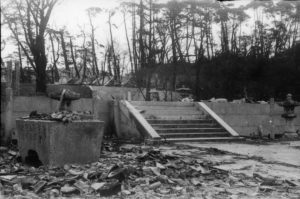Documenting Hiroshima of 1945: Late August, leaning on each other at Nigitsu Shrine
Aug. 26, 2024
by Kyoko Niiyama and Maho Yamamoto, Staff Writers
In late August 1945, Nigitsu Shrine, located in Hiroshima City’s present-day Higashi Ward, was in a pitiful state, with its main building and karamon Chinese gate destroyed in the atomic bombing. The shrine, dedicated to the successive rulers of the Asano clan, the rulers of the former Hiroshima domain, is located around 1.8 kilometers northeast of the hypocenter. A provisional relief station was established at the shrine, which accepted many victims of the bombing.
Fumie Yoshida, 95, a resident of Hiroshima’s Higashi Ward who had lost her home located next to the shrine, stayed on the shrine’s grounds for about one month after the bombing. She was 16 at the time and a fourth-year student at Hijiyama Girls’ High School (present-day Hijiyama Girls’ Junior and Senior High School).
After experiencing the atomic bombing at the location to which she had been assigned to work as a mobilized student in Hiroshima’s present-day Minami Ward, she fled to the shrine with her classmates, thinking she “might be able to meet up with her family there.” Fortunately, she was able to reunite with her mother, Akiko, who died in 1998 at the age of 95, on the shrine grounds crowded with people seeking refuge. They received two tatami mats from a neighbor and used something like fusuma sliding door panels as a roof to protect them from rain and due.
She and her mother walked around the incinerated ruins of the city in search of other family members. Her younger sister, Yukie, seven at the time, was found dead under a beam of their house, and the remains of her older sister, Suzue, 19, were found in the burned-out ruins of the place where she had worked. Her father, Raijiro, 50 at the time, was never found.
Ms. Yoshida has many recollections of the shrine from long ago. “I used to run around and play with my neighborhood friends. I have many good memories,” she said. However, she remembers more often the days when she and her mother survived by encouraging each other, faced with the deaths of family members.
On August 20, Masami Oki, who worked at the Kure Naval Arsenal, photographed the shrine grounds, on which debris was scattered about. According to Ms. Yoshida, the number of people seeking refuge decreased as time passed.
(Originally published on August 26, 2024)
In late August 1945, Nigitsu Shrine, located in Hiroshima City’s present-day Higashi Ward, was in a pitiful state, with its main building and karamon Chinese gate destroyed in the atomic bombing. The shrine, dedicated to the successive rulers of the Asano clan, the rulers of the former Hiroshima domain, is located around 1.8 kilometers northeast of the hypocenter. A provisional relief station was established at the shrine, which accepted many victims of the bombing.
Fumie Yoshida, 95, a resident of Hiroshima’s Higashi Ward who had lost her home located next to the shrine, stayed on the shrine’s grounds for about one month after the bombing. She was 16 at the time and a fourth-year student at Hijiyama Girls’ High School (present-day Hijiyama Girls’ Junior and Senior High School).
After experiencing the atomic bombing at the location to which she had been assigned to work as a mobilized student in Hiroshima’s present-day Minami Ward, she fled to the shrine with her classmates, thinking she “might be able to meet up with her family there.” Fortunately, she was able to reunite with her mother, Akiko, who died in 1998 at the age of 95, on the shrine grounds crowded with people seeking refuge. They received two tatami mats from a neighbor and used something like fusuma sliding door panels as a roof to protect them from rain and due.
She and her mother walked around the incinerated ruins of the city in search of other family members. Her younger sister, Yukie, seven at the time, was found dead under a beam of their house, and the remains of her older sister, Suzue, 19, were found in the burned-out ruins of the place where she had worked. Her father, Raijiro, 50 at the time, was never found.
Ms. Yoshida has many recollections of the shrine from long ago. “I used to run around and play with my neighborhood friends. I have many good memories,” she said. However, she remembers more often the days when she and her mother survived by encouraging each other, faced with the deaths of family members.
On August 20, Masami Oki, who worked at the Kure Naval Arsenal, photographed the shrine grounds, on which debris was scattered about. According to Ms. Yoshida, the number of people seeking refuge decreased as time passed.
(Originally published on August 26, 2024)








